Consider this scenario where your application crashes out of the blue, or your website is slower than normal, and you don’t know the cause. Is it a server problem, or is it a code issue?
In this situation, Datadog and New Relic become helpful for your problems. These are powerful observability tools that evaluate the performance and health of your systems. These tools also catch issues before your users do and deal with proper resolutions; this process means you turn the impossible troubleshooting paradigm into action.
Both platforms monitor efficiently and effectively, though their strengths are decidedly different. Understanding the differences between the two is important to make sure you are selecting the right observability platform for your needs.
In this article, you will see a detailed comparison of Datadog vs New Relic on various features so that you can select the best one for your use case.
Feature Comparison of Datadog vs New Relic
Datadog vs New Relic: Infrastructure Monitoring
Datadog offers end-to-end infrastructure visibility across cloud-native workloads, containers running on Kubernetes, and other environments. With 500 integrations, you can auto-discover your resources and use pre-built dashboards for AWS and GCP. Its agent-based model dynamically detects and monitors new resources as you scale.
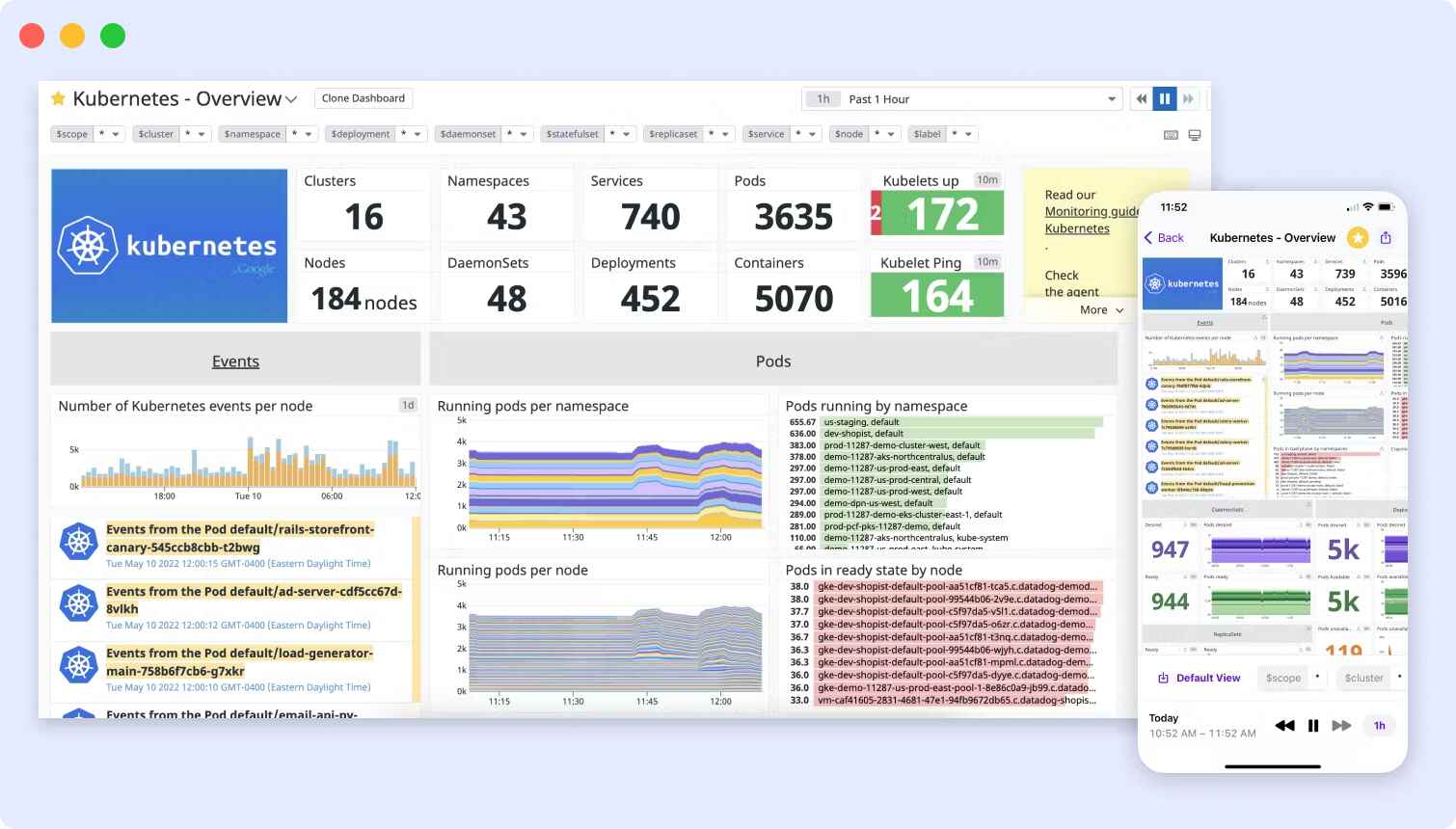
New Relic adopts a contextualized view of infrastructure monitoring, with application performance data surfaced in that same experience. It has both agent-based and agentless monitoring options available to customize monitoring via OpenTelemetry and Flex Integration. Compared to Datadog, its Kubernetes monitoring capabilities are not as rich.

Verdict: New Relic is excellent at linking infrastructure problems to application performance, whereas Datadog wins for the variety of infrastructure monitoring features and connectors.
Datadog vs New Relic: Log Management
Datadog provides real-time log processing, indexing, and centralized log collection from various sources. A log pattern is automatically identified, and anomalies are highlighted using machine learning (ML).
Its powerful query language simplifies browsing through logs and correlating them with metrics and traces. Users can view tail logs, filter them based on services, and correlate logs with metrics and traces seamlessly.
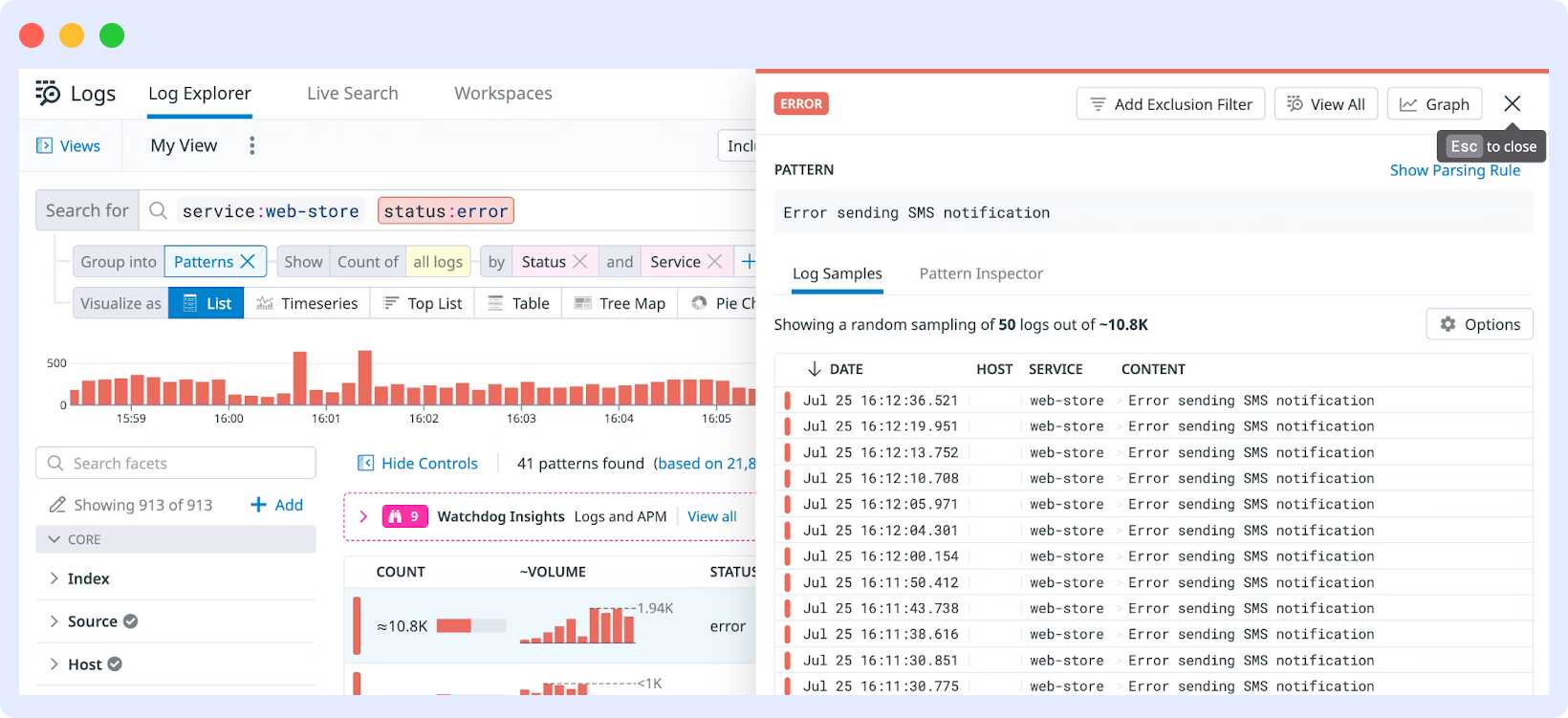
New Relic’s log management integrates into its unified platform. The “Logs in Context” feature makes troubleshooting easy by showing logs with APM data, and the log patterns feature lessens the noise of logs by efficiently grouping similar messages.
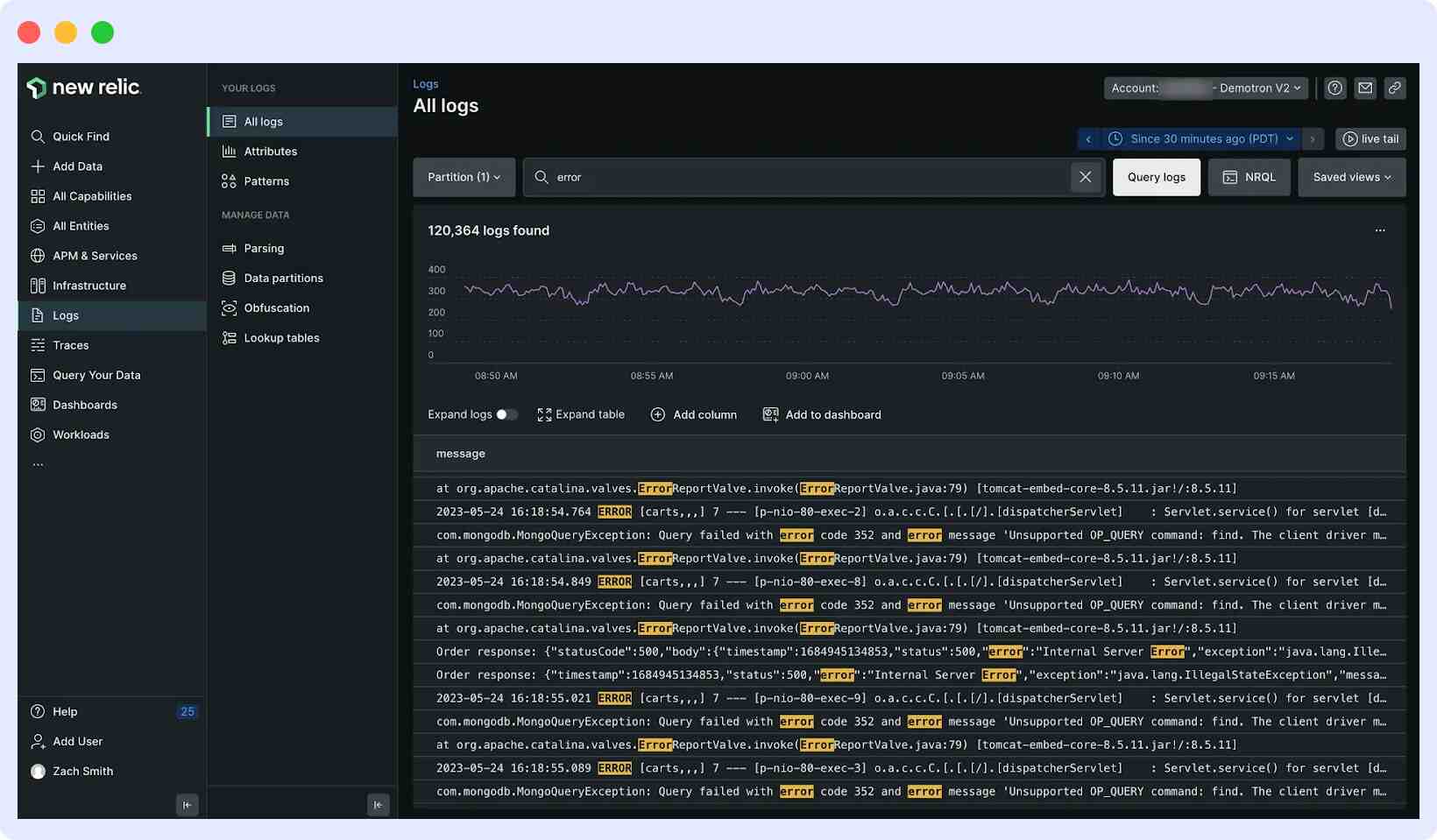
Verdict: Each tool shines in its area: Datadog for real-time log analysis flexibility and New Relic for ease of use with its unified platform and less expensive long-term storage.
New Relic vs Datadog: Application Performance Monitoring (APM)
Datadog APM provides distributed tracing paired with service dependency mapping using visual service maps. It provides code-level visibility, database performance monitoring, and AI root cause analysis. The continuous profiler helps pinpoint code-level bottlenecks at very low overhead.
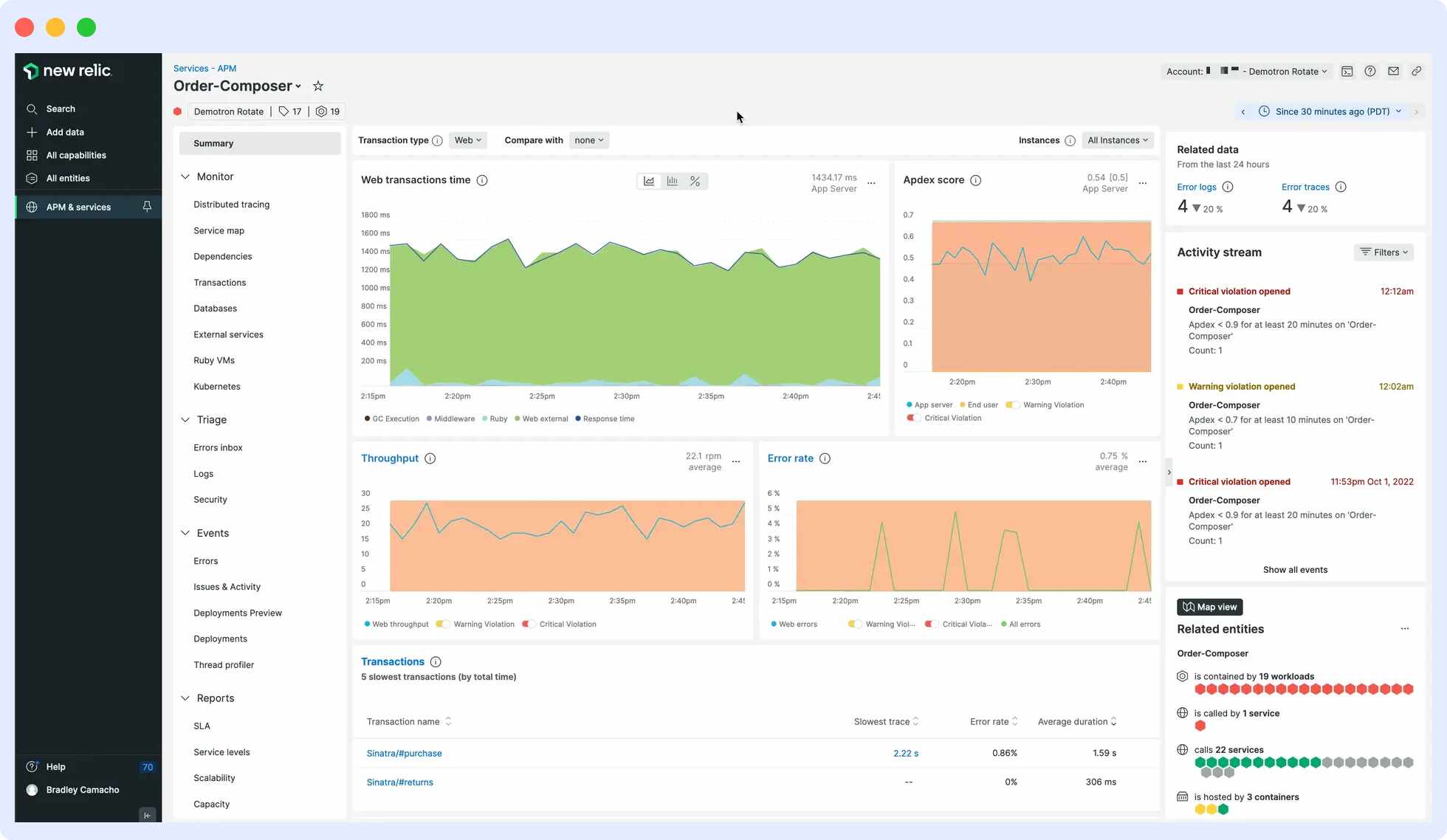
New Relic APM provides full-stack observability through a simple installation process across common programming languages and frameworks. The agent-based architecture provides precise transaction data in distributed systems with the best code-level observability to easily identify code issues.

Verdict: New Relic has a slight edge with deeper code-level diagnostics and a more mature APM product. The company has invested in this capability from day one.
New Relic vs Datadog: Real User Monitoring (RUM)
Datadog RUM tracks end-user interactions across web and mobile apps with real-time session replay, error tracking, and frontend performance monitoring. RUM has an out-of-the-box integration with APM for a complete view of the user experience, including the ability to replay actual user sessions.
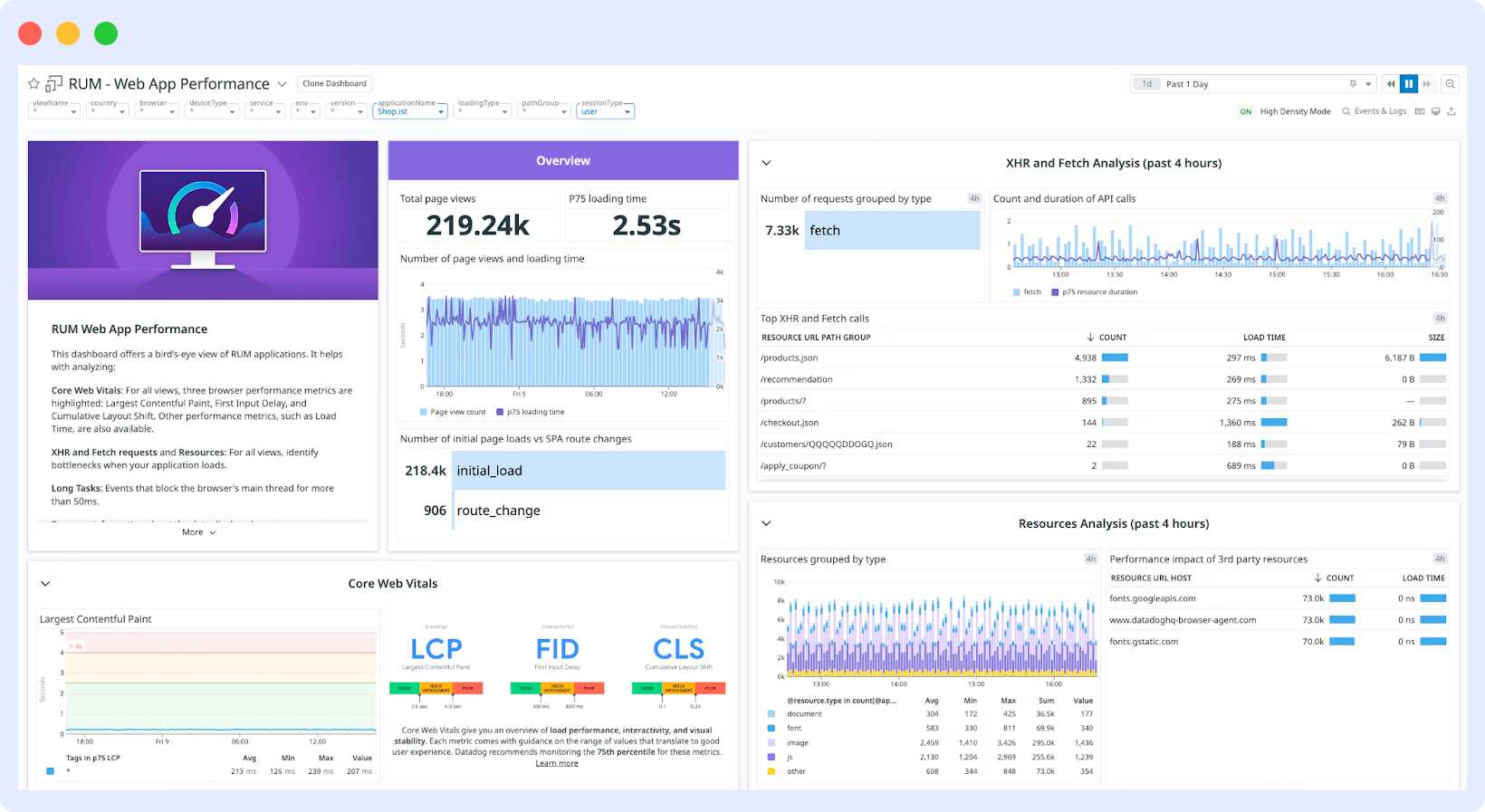
New Relic provides basic RUM capabilities for free, which include page loads, interactions, and JavaScript errors. Browser and Mobile monitoring connects frontend and backend performance with user journey analytics for a better understanding of the overall customer experience.
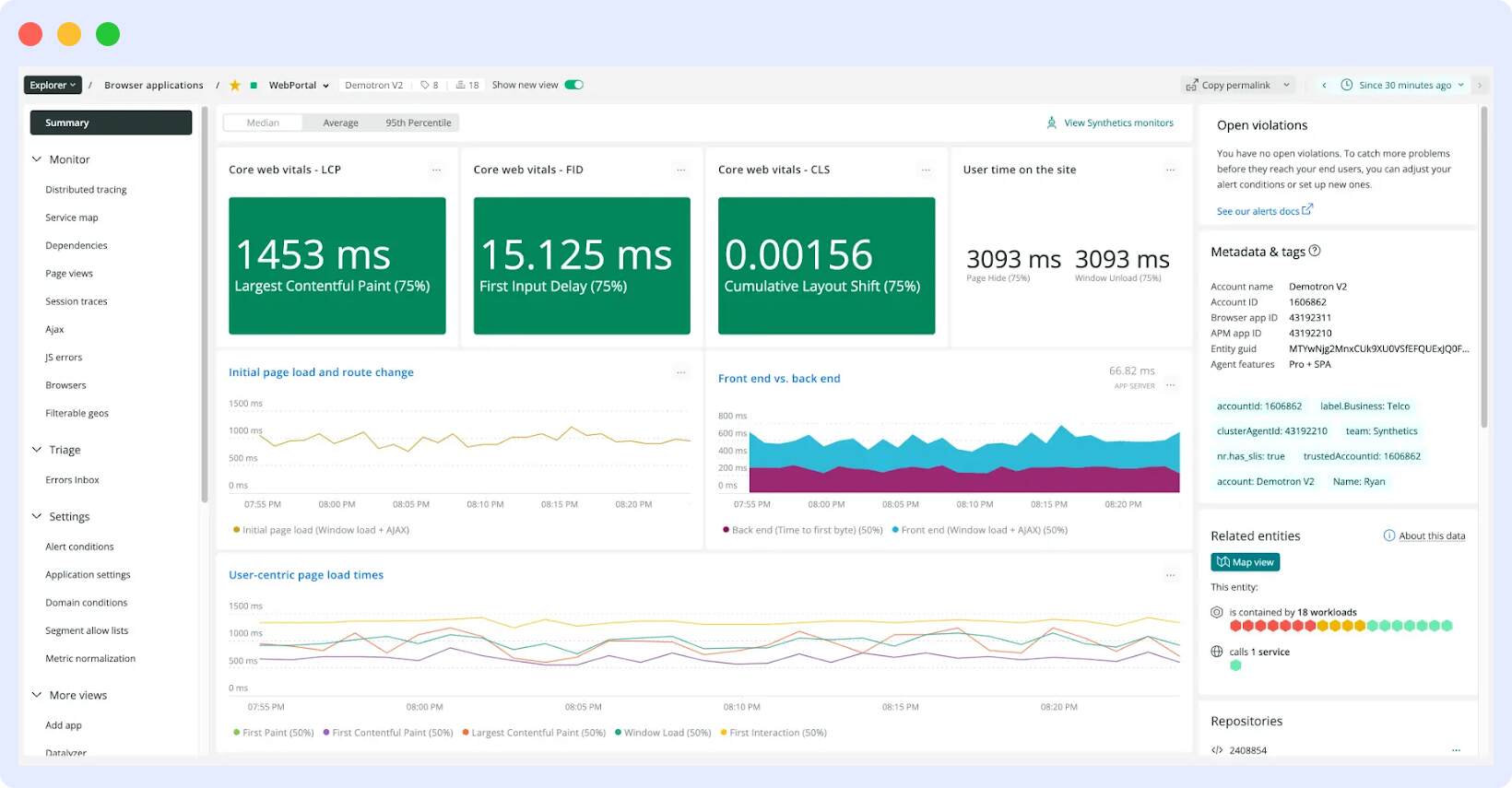
Verdict: Datadog is ahead with session replay and increased device coverage, New Relic has a more seamless frontend-backend monitoring integration.
New Relic vs Datadog: Incident Management & Alerts
Datadog provides alerts that can be customized, and anomaly detection and forecasting capabilities. It has an intelligent alerting system that prioritizes events and recommends actions. Incident management tools provide on-call schedules and documentation of escalation paths.
New Relic provides customizable, predictive alerts for performance problems with AI functionality. The NRQL query language provides you with precise conditions for alerts, and incident intelligence can automatically correlate similar alerts to reduce noise.
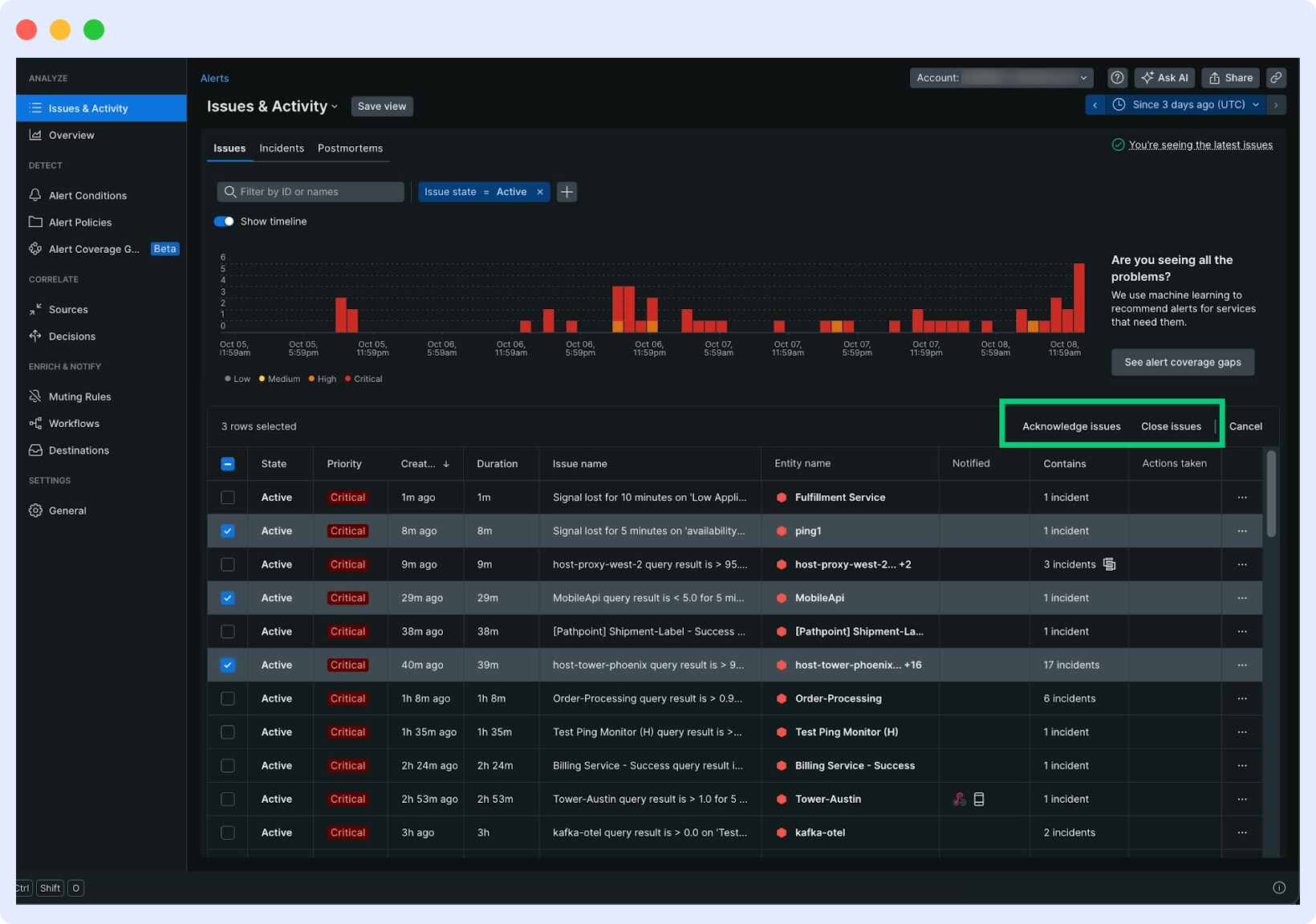
Verdict: Tie. Both platforms have solid alerting systems, although Datadog has more flexible alerting systems, while New Relic has better alert correlation capabilities.
Datadog vs New Relic: Security Monitoring
Datadog’s built-in security monitoring blocks threats, validates compliance, and provides security visibility in real time using your existing logs and metrics. There is no need for additional agents as built-in out-of-the-box detection rules are available. You can also leverage detections generated by AWS GuardDuty or other security tools that you may use in your environment.
New Relic includes a security vulnerability scan and runtime security monitoring. However, it has limited threat detection and security automation capabilities, primarily focusing on infrastructure agent vulnerability monitoring.
Verdict: Datadog wins by offering a more inclusive security monitoring solution that is native to their platform.
Datadog vs New Relic: OpenTelemetry Support
Datadog supports OpenTelemetry for telemetry data collection, while also retaining powerful visuals and analytic capabilities. However, its proprietary agents and SDKs remain a priority, preventing complete openness.
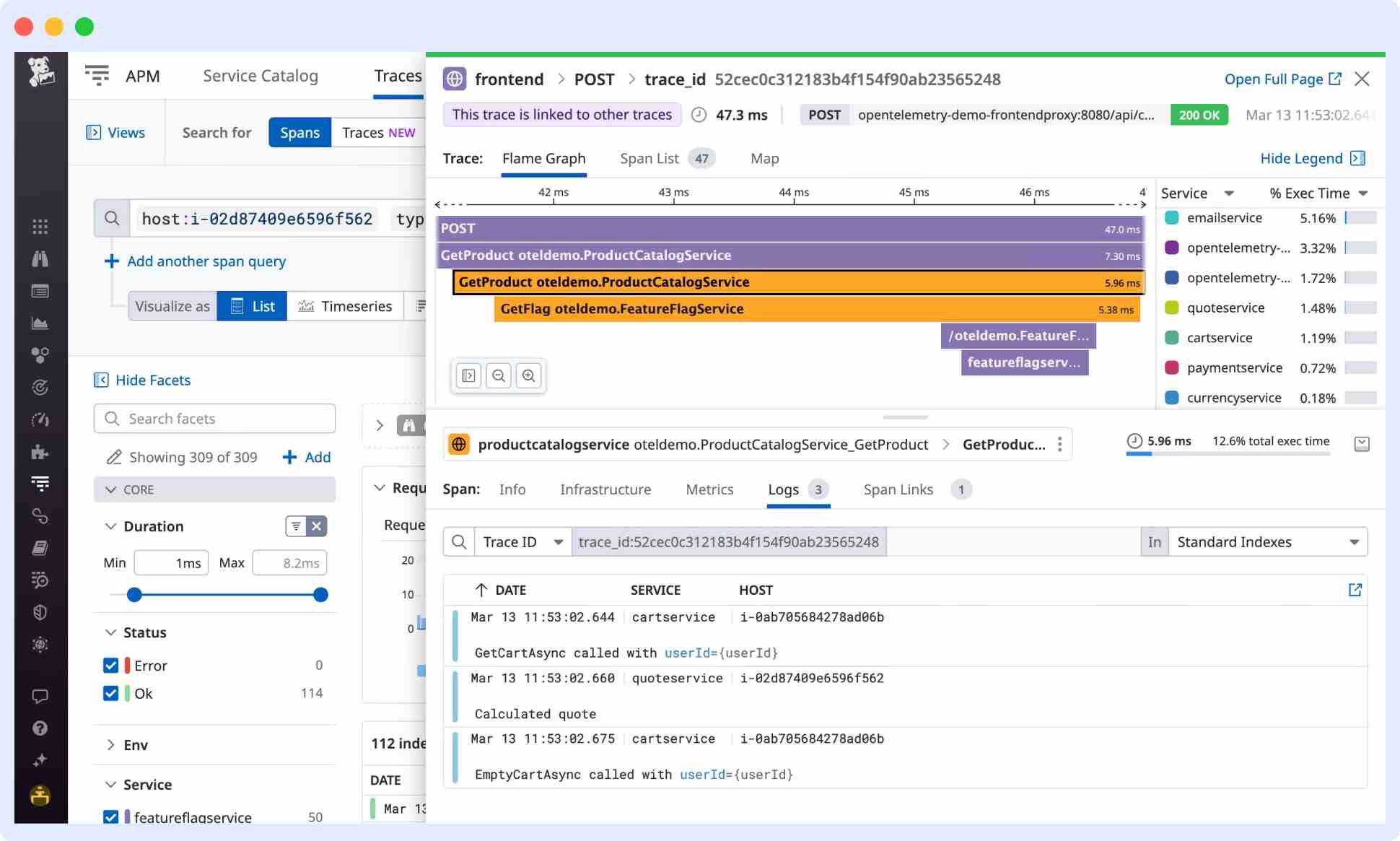
New Relic has strong OpenTelemetry support, enabling seamless data transfer without proprietary agents. It has made OpenTelemetry part of its core technology strategy with native support to show its commitment to the OpenTelemetry project.
Verdict: New Relic is the victor with a better implementation of OpenTelemetry and full support of the specification.
Datadog vs New Relic: Ease of Integration & Deployment
Datadog offers 500+ ready-to-use integrations with minimal setup requirements and a straightforward guided process for agent installation.
New Relic provides numerous integrations with an especially user-friendly guided installation process for quick monitoring setup.
Verdict: Datadog wins with more turnkey integrations, though New Relic offers a slightly more streamlined initial setup.
Datadog vs New Relic: UI & UX
Datadog has a customizable dashboard builder that can be adapted for each user; however, it’s easy for a beginner to get confused with too many options.
New Relic One has a smoother overall user experience with an entity-centric framework that makes it easier to navigate between interconnected resources.
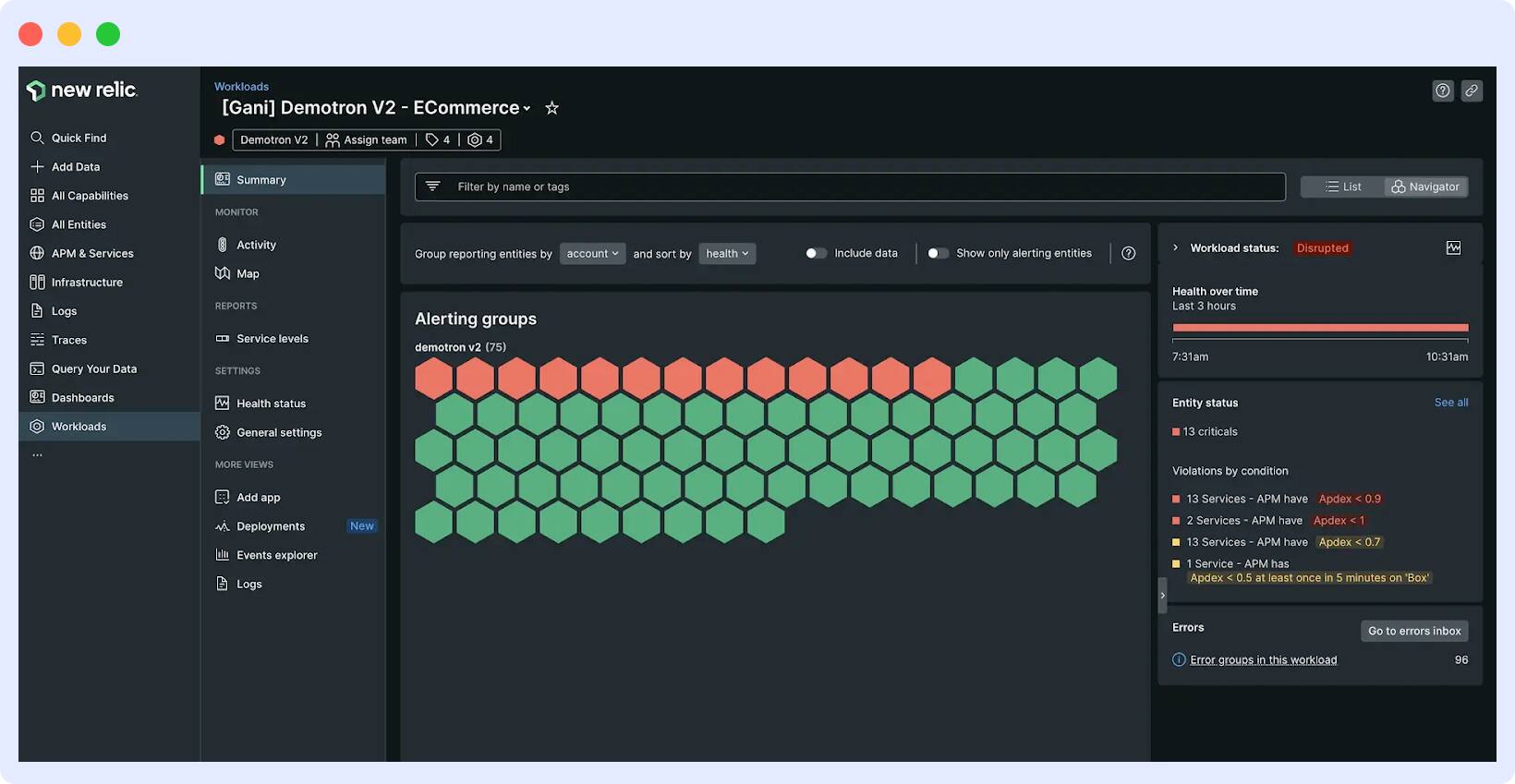
Verdict: New Relic wins due to its efficiency and more user-friendly interface, especially for beginners.
New Relic vs Datadog: Data Querying & Visualization
Datadog utilizes a simple query language for metrics aggregation and advanced log queries, with a vast set of visualizations, such as dashboard widgets and different chart styles
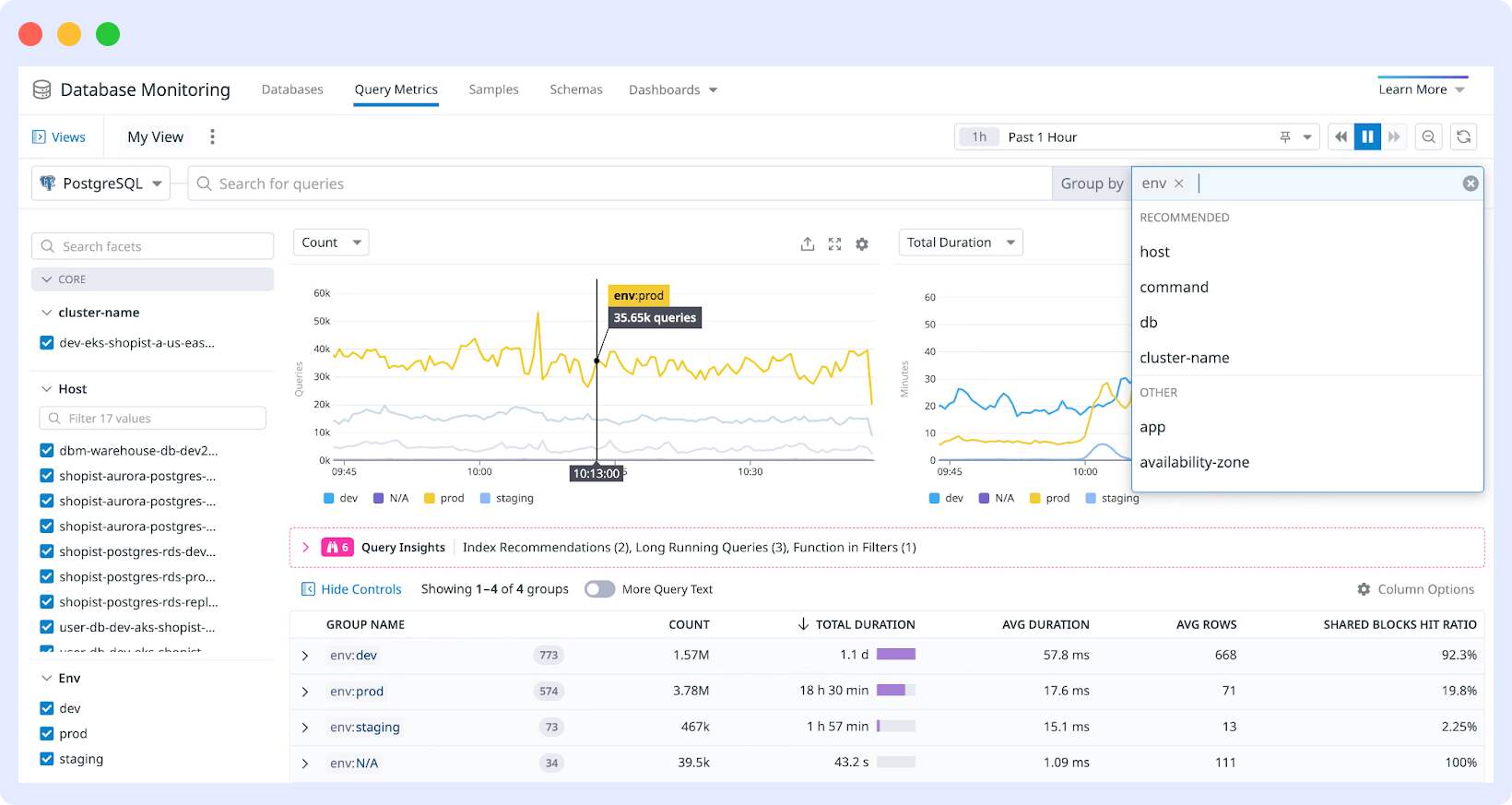
New Relic provides a query language, NRQL, that appears to follow standard SQL syntax and has a unique ability to query complex metrics effectively; however, its visualization capabilities are not as extensive as Datadog’s differentiated visualizations.

Verdict: Tie. They both have advantages in different areas, with Datadog having the advantage of visualization flexibility, and New Relic having query capabilities with the query language of NRQL.
Datadog vs New Relic: Team Management & Access Control
Datadog provides role-based access control that can restrict access by team, integration, or metric. It offers team management capabilities that facilitate collaboration within large organizations.
New Relic has similar access control features with an emphasis on sharing relevant information between teams and maintaining secure boundaries.

Verdict: It’s a tie. Both products offer a powerful, flexible access control and team management feature set that is suitable for organizations of any size.
Datadog vs New Relic: Pricing
Datadog uses a modular pricing model, where you pay separately based on usage for each product (APM, infrastructure, logs, etc.). This may potentially be a better value if you need only some features.
New Relic is engaging companies in a consumption-based model focusing on how much data they ingest and how many users access the application. Their pricing is structured to be more predictable as your company uses their all-in-one platform.
Verdict: New Relic is usually a better value for businesses using multiple monitoring features because of its much simpler and more predictable pricing.
“Compared to other observability solutions, Middleware offered similar or even superior capabilities at a much lower cost, eliminating the need for expensive tiered pricing or additional charges for advanced features. This made Middleware a more accessible and scalable solution for a business like ours. In fact, we were able to reduce our costs by 75%.”
Krishna Charan BS, Information Security Head, MindOrigin
New Relic vs Datadog: Third-Party & Community Reviews
Datadog consistently improves its ratings on factors such as speed of innovation and the breadth of features, especially in dashboarding capabilities and breadth of infrastructure monitoring.
New Relic is regularly recognized for its platform cohesiveness, user experience, and excellence in its APM solution, regularly ranking very high in third-party ratings.
Verdict: Both platforms are favorably rated, Datadog for innovation and breadth of features, and New Relic for platform cohesiveness and usability.
Datadog vs New Relic: Strengths Summary
Datadog’s core strength is in its available integrations, security monitoring, infrastructure monitoring, and flexible and customizable dashboards. This observation is supported by the fact that Datadog is built to extract value in complex, heterogeneous environments.
New Relic scores highest with its unified interface for all features, advanced APM capabilities, superior UI, and enhanced pricing capabilities. The product shines especially in its ability to correlate user experience to backend performance.
Verdict: Datadog is preferable for mixed infrastructure monitoring and is the best option; use New Relic for application performance monitoring and a unified platform.
Issues
Datadog users encounter a considerable learning curve and possible cost issues, as there might be too many options for new users.
New Relic users sometimes say there are limits to customization options and integration, with some users having trouble adapting after changes to New Relic’s pricing model.
Verdict: Datadog suffers from slow development speed and the cost of scaling; New Relic suffers from limits to customization and integration.
Datadog vs New Relic: Use Case Scenarios When to Choose Which One?
When to choose Datadog?
- When you want to monitor a large number of computers and containers across multiple cloud providers.
- When it is so important to you that you want to be sure of the safety and security of your system, even if it does affect your overall performance.
- If you’re looking for an excellent way to create dashboards that combine visuals in a variety of ways.
When to choose New Relic?
- If an application’s performance is your primary source of concern.
- If you lack enthusiasm for unified platform features that differ in appearance and behavior.
- If your group would rather keep things simple than heavily customize the application.
- If you have access to all the services, you would prefer to have a fixed price tag.
Verdict: Your ideal choice depends on your exact demands—Datadog for flexibility and breadth, New Relic for cohesion and ease of use.
A Better Alternative: Middleware
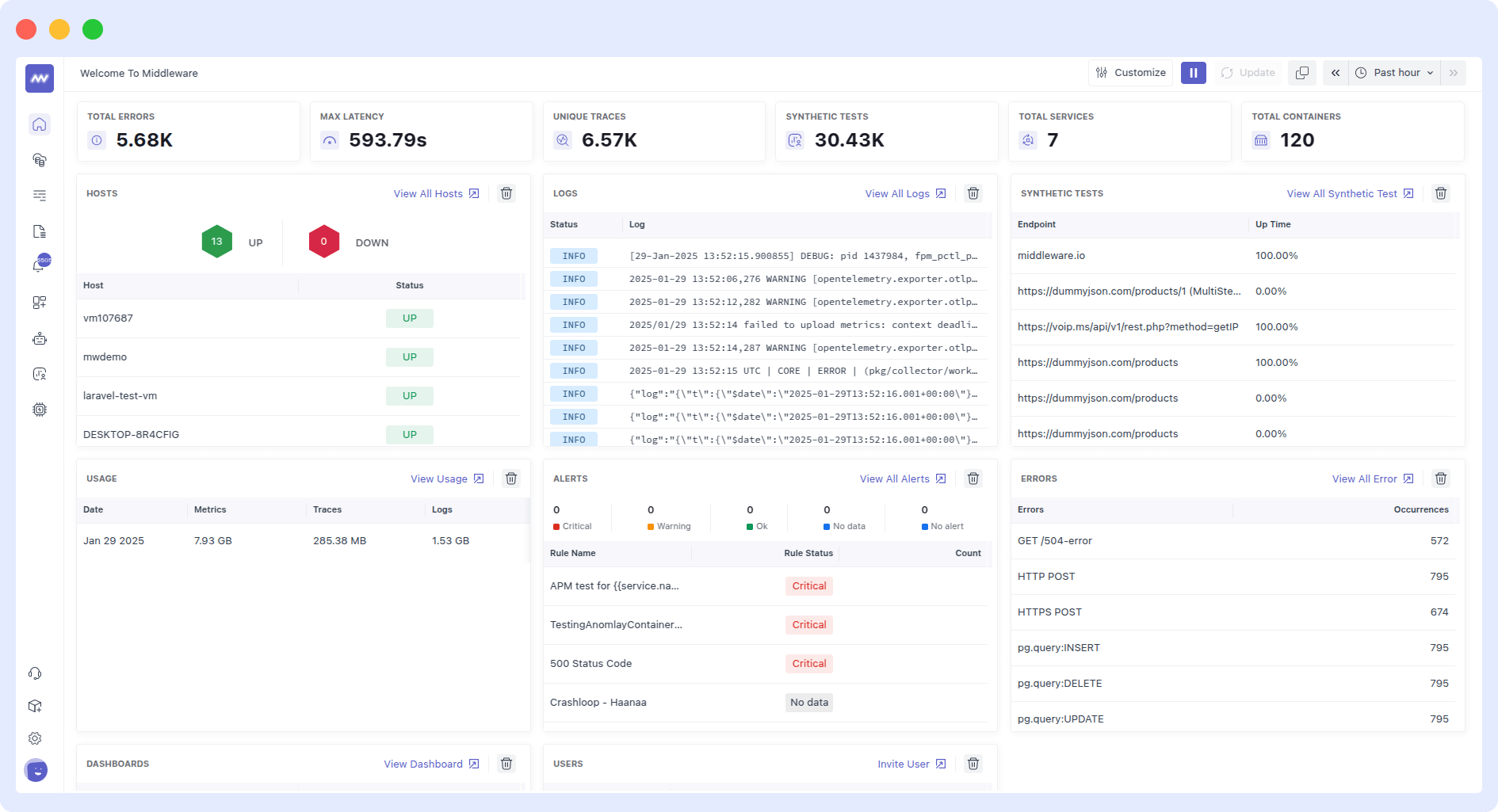
Middleware offers a complete observability solution that addresses the limitations of both Datadog and New Relic with end-to-end monitoring, unified telemetry data view, better pricing, and 24/7 global customer support. Try Middleware for full visibility across your tech stack with cost-effective, comprehensive monitoring.
Key Features of Middleware:
- All-in-One Observability: Seamlessly combines metrics, logs, traces, and user monitoring into a genuinely unified experience
- Cost-Effective Pricing: Transparent, predictable pricing model with no hidden costs.
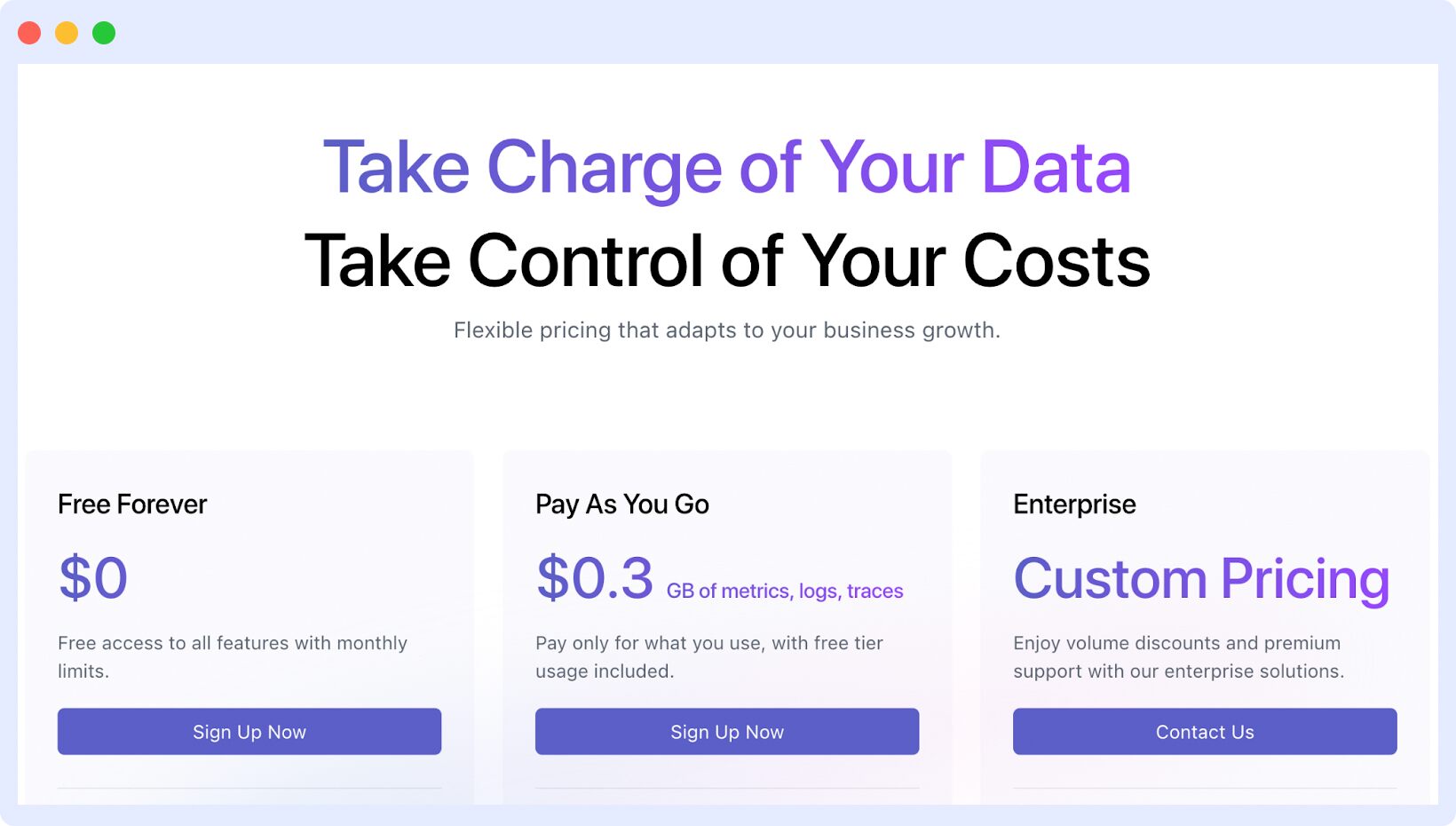
- Zero-Configuration Setup: Start monitoring in minutes with auto-discovery and a streamlined onboarding process
- Infrastructure & Application Monitoring: Get comprehensive visibility on your whole tech stack.
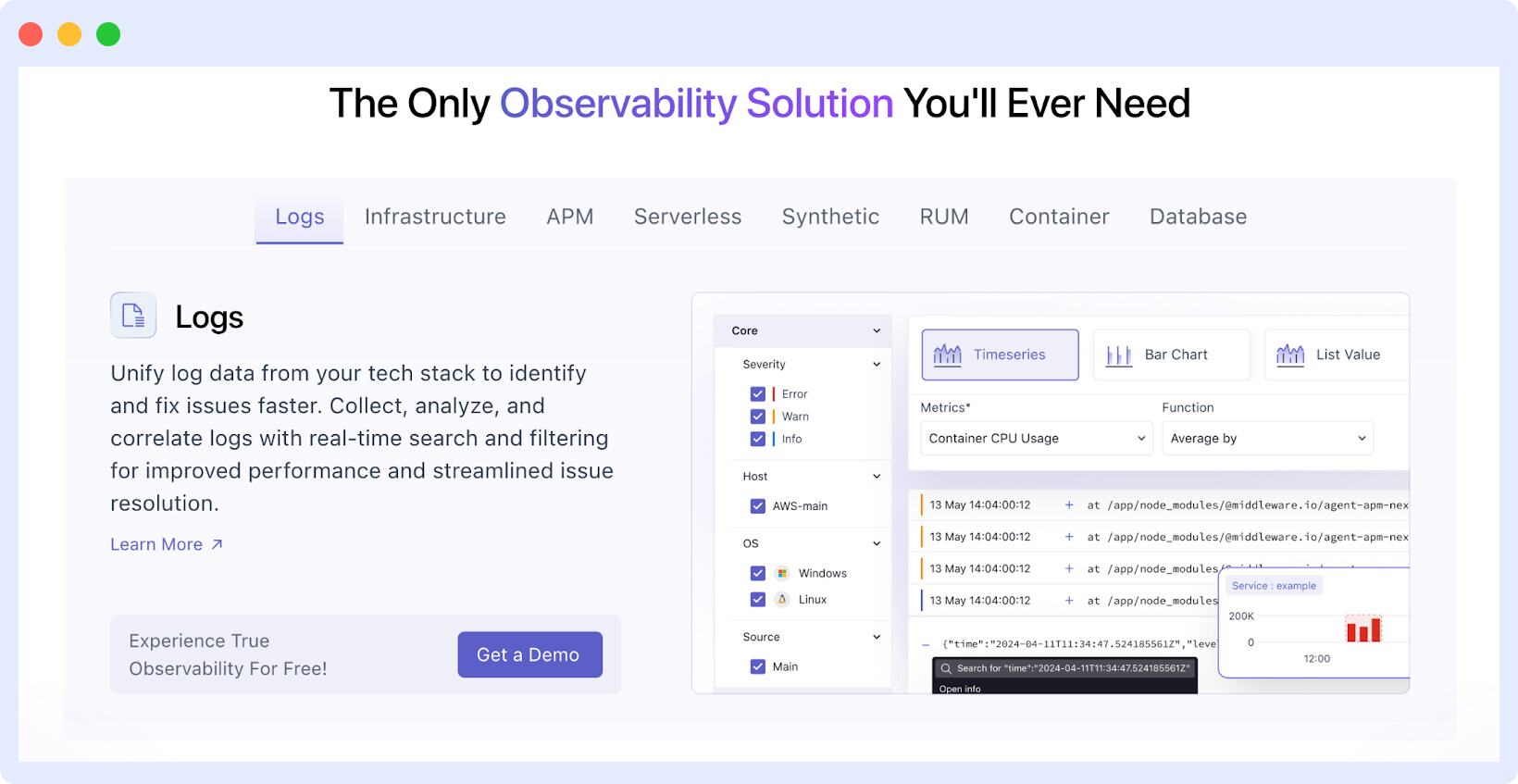
- Advanced Anomaly Detection: AI-assisted alerts reduce false positives and noise in the system.
- Custom Dashboards: Easy drag-and-drop dashboard creation to customize and create views that you prefer.
- OpenTelemetry Native: Built with open standards for maximum flexibility and protection against obsolescence.
- Real-Time Analytics: Get immediate insights into performance issues and always know when there’s a performance problem without sampling.
Want to see better value in observability? Go to Middleware and start your free trial today! Middleware provides a complete setup guide that can help you learn how Middleware simplifies monitoring and offers you better insights than your legacy solution.




